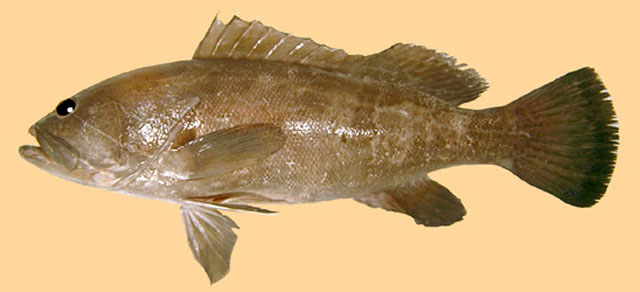| Epinephelidae (Groupers) |
| 120 cm TL (male/unsexed); max.weight: 25 kg |
|
demersal; brackish; marine; depth range 20 - 200 m, oceanodromous |
| Eastern Atlantic: along the west coast of Africa to southern Angola (Ref. 5222, 57293), including the southern Mediterranean (Ref. 5222). First record from Corsica, France in 2012 (Ref. 95840). Records from the Canary Islands and Cape Verde are unsubstantiated (Ref. 5222). |
|
Dorsal spines (total): 10-11; Dorsal soft rays (total): 14-16; Anal spines: 3-3; Anal soft rays: 7-9. Diagnosis: depth of body less than head length, depth 3.0-3.6 times in SL; head length 2.5-2.9 times in SL; interorbital area convex; preopercle angular, 3.6- large spines at the angle, lowermost directed ventrally; posterior nostril slightly bigger than anterior nostril; maxilla reaches nearly to vertical at rear edge of eye; pelvic fin origin below base of pectoral fins; rounded caudal fin; body scales ctenoid (Ref. 89707).
Description: body rather elongate; lower jaw prominent; teeth of inner row depressible in both jaws; scales small, slightly imbricate and embedded in the thick skin (Ref. 57293).
Coloration: ground colour dark reddish-brown or greyish-green, sometimes with more or less distinct lighter crossbars; 3-4 oblique whitish lines on cheeks and gill covers (Ref. 57293). |
| Adults are found on rocky or mud-sand bottom; juveniles have been taken in coastal lagoons and estuaries (Ref. 5222, 57293). In the west African waters, diet comprise of fishes (58%), stomatopods (21%), crabs (10%), and cephalopods (10%). It is a protogynous hermaphrodite. The seasonal migration of the species off the coast of Senegal is influenced by the seasonal upwelling off Senegal and Mauritania. Utilized fresh and smoked (Ref. 9987). Highly esteemed in the market of West Africa (Ref. 5377). |
|
Near Threatened (NT); Date assessed: 18 November 2016 (A2bd) Ref. (130435)
|
| harmless |
Source and more info: www.fishbase.org. For personal, classroom, and other internal use only. Not for publication.

